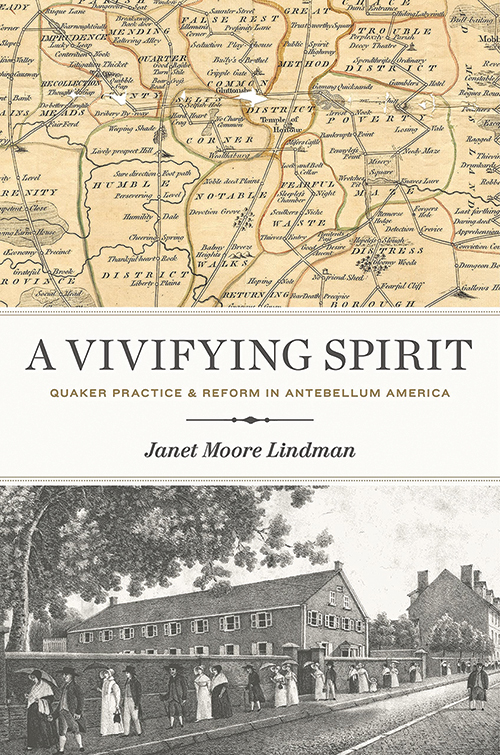
A Vivifying Spirit: Quaker Practice and Reform in Antebellum America
Reviewed by Brian Drayton
February 1, 2023
By Janet Moore Lindman. The Pennsylvania State University Press, 2022. 284 pages. $119.95/hardcover; $95.99/eBook.
A Vivifying Spirit begins with reflections upon a Quaker document I’d never heard of before: A Map of the Various Paths of Life by George Dillwyn, a leading Philadelphia minister. One might call it a flow chart showing different ways in which a Friend might progress in faithfulness to the Light, or become deflected from the path of spiritual health by the vicissitudes and temptations of life. The map, which owes obvious debts to John Bunyan’s Pilgrim’s Progress, also represents something of the conceptual framework an active minister might have in his or her head, as they sought in worship to be of service to their fellow worshipers, and encourage them along their own actual paths of life.
Lindman’s book traces the development of what she calls the multiple “American Quakerisms” during the years roughly between the American Revolution and the Civil War. Dillwyn’s map is a helpful reference point because Lindman is examining changes in the way Friends interpreted and responded to the spiritual challenges that life presents, and the shifting roles of Scripture, Quaker history, and community guidance.
Her first section explores Quaker attitudes and beliefs in the context of practices of piety (including worship and plainness); the education of children; and the pedagogy of death (that is, the ways in which the lives of departed Friends were taken as lessons for the living).
Her second section, “Fruitless Exercise and Distress,” treats the Hicksite separation; the Wilbur-Gurney controversy; and the emergence of “reforming Quakerism,” which construed faithfulness in terms of engagement with social ills, whether in the antislavery or women’s rights movements, prison reform, or the temperance movement.
Her final section, comprising just two chapters, addresses the Quaker print and manuscript culture, and the uses that Friends made of Quaker history, as they articulated and defended the Quakerism that they felt led to enact.
The author draws on a wide range of documentary sources published and unpublished, and seeks to weave a coherent and accessible narrative about a highly complex, always-mutating movement. The differences, the separations, and rejoinings are kaleidoscopic and present the historian with a strenuous challenge. There are times when the details seem to escape the author’s control momentarily, and the description of piety as lived in each of the Quaker tribes could have benefited from a richer and more experiential treatment.
I think this book would be of interest and use to any Friend who wants a general overview of the flow of U.S. Quaker development during the period treated, and the author’s bibliography is excellent as a jumping-off place for further reading. Perhaps, however, the book should be read alongside such treatments as H. Larry Ingle’s Quakers in Conflict: The Hicksite Reformation or Jack Marietta’s The Reformation of American Quakerism, 1748–1783. I must note that, once again, the Quakerism described is primarily Philadelphia Yearly Meeting’s (though other bodies are mentioned here and there), as is too often the case in studies of U.S. Quaker history. Finally, the very high price of the book will make it accessible mostly to libraries of large meetings or of universities, so that it’s not likely to serve study groups in local meetings.
Brian Drayton worships with Souhegan Preparative Meeting in southern New Hampshire.



Comments on Friendsjournal.org may be used in the Forum of the print magazine and may be edited for length and clarity.